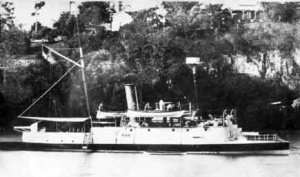Acquired to deal with the perceived threat from the Russian Pacific fleet, Gayundah and its fellow ship Paluma were the first vessels ordered by the Queensland government for the colony's Maritime Defence Force. Their names are Indigenous words for 'lightning' and 'thunder' respectively. Built at a cost of £35,000 each, the vessels were of a 'flat iron' design and mounted a formidable armament for their size. Both ships carried out trials on 26 September 1884, and reached a speed slightly over 10.5 knots in full power trials over a ten mile course.
Gayundah sailed from Newcastle-on-Tyne for Australia under the command of Captain Henry Townley-Wright RN on 13 November 1884. Townley-Wright had been appointed Senior Naval Officer of the Queensland Maritime Defence Force in 1881. Proceeding via Gibraltar, Malta, Suez, Aden, Colombo, Batavia, Thursday Island and Townsville, Gayundah arrived at Brisbane on 28 March 1885. Being fitted with masts and yards, it carried sails to assist during the long journey. Thereafter Gayundah's chief duties were the protection of Moreton Bay and training ship for the Queensland Maritime Defence Force.
In 1886 the Queensland government offered to place Guyundah at the disposal of the Admiralty if required and Rear Admiral George Tyron, the Commander-in-Chief, Australia Station, subsequently authorised the gunboat to wear the White Ensign of Her Majesty's Fleet. This caused problems in 1888 when, after disagreement over salary, Captain Townley-Wright was ordered to pass command to his first lieutenant, Francis Taylor. Reluctant to comply, and arguing that because his ship wore the White Ensign he was not under Queensland authority, Townley-Wright moored Gayundah in the middle of the Brisbane River and threatened to sail for Sydney. A boarding party led by the Police Commissioner, DT Seymour, arrested Townley-Wright at gunpoint and defused the crisis. On 30 September 1892 Gayundah was laid up in reserve in Brisbane. Although paid off, it was crewed as required and used for training members of the Queensland Naval Brigade. In 1898 Gayundah recommissioned under the Queensland Blue Ensign.
Following Federation in 1901 Gayundah became a unit of the Commonwealth Naval Forces, but owing to administrative delays control did not pass to the new Commonwealth government until 1904. Gayundah remained in Queensland waters and on 9 April 1903 won some claim to fame when it carried out the first ship-to-shore wireless telegraphy experiments in Australia. The ship's aerial was kept aloft by a tall bamboo pole lashed to the foremast. The historic message was received in Brisbane and read: 'Gun drill continued this afternoon and was fairly successful - blowing squally and raining - prize firing tomorrow. Marconi insulators were interfered with by rain but easily rectified and communication since has been good. Good night.'
In 1911 Gayundah spent several months on a 'special cruise', aimed at enforcing Australian sovereignty in north western waters. It was the first such operation for the nascent Australian Navy.
Gayundah continued to provide reserve training and on occasion a venue for entertaining senior officials. At the 1913 'Henley on Brisbane' aquatic carnival, it carried the Governor of Queensland, Sir William MacGregor, and other dignitaries.
While undergoing repairs in Sydney during 1913-14 Gayundah received some structural alterations, a raised forecastle taking the place of the turtleback forward. The 6-inch forward gun, which had replaced the original 8-inch gun was also removed. The alterations increased accommodation in the ship and improved sea-keeping and habitability.
After the outbreak of the First World War, the ship returned to Queensland waters, and although one of the RAN's oldest vessels, performed useful service. Initially it acted as a Moreton Bay guardship and examination vessel at Brisbane. In January 1915 the ship returned to Sydney, and in July that year one of its 12-pounder guns was removed for installation in the sloop HMAS Fantome. With the threat from German merchant raiders increasing after 1917, Gayundah assumed patrol duties, first off Port Jackson and later in the Spencer Gulf.
On 23 August 1918 Gayundah finally paid off in Melbourne. Sold in 1921 to Brisbane Gravel Pty Ltd, it returned to Queensland and began a long and useful career as a sand and gravel barge. It sank at its moorings at Melton Reach, near Brisbane, in October 1930 but was soon raised and back at work. Early in 1958 it was towed to Bulimba Wharf in Brisbane and stripped, with the hull then sold to the Redcliffe Town Council. On 2 June 1958, after 74 years afloat, Gayundah was beached as a breakwater off the Woody Point cliffs on the Redcliffe Peninsula just north of Brisbane. Its remains are still visible.
Specifications
 |
| Class |
Gunboat Class |
|---|---|
| Builder |
Sir WG Armstrong, Mitchell & Co, Newcastle-on-Tyne |
| Launched |
13 May 1884 |
| Commissioned |
26 September 1884 |
| Decommissioned |
23 August 1918 |
| Dimensions & Displacement | |
| Displacement | 360 tons |
| Length | 120 feet (36 metres) |
| Beam | 26 feet |
| Draught | 9 feet 6 inches |
| Performance | |
| Speed | 10.5 knots |
| Range | 700-800 miles |
| Complement | |
| Crew | 55 |
| Propulsion | |
| Machinery | Horizontal direct action compound steam engines, twin screws |
| Horsepower | 400 |
| Armament | |
| Guns |
|





